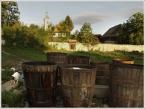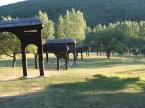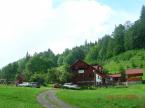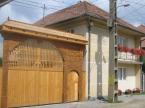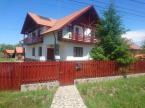Information
WIKI REFRESH Braºov (pronunciation in Romanian:
- name in Hungarian: Brassó, German: Kronstadt) is a city in Romania, capital city of Braºov County. The population of Braºov is 284,596, according to the 2002 census.
A large longwave broadcasting facility is located near Braºov, at Bod.
Also the city is the host of The Golden Stag (Cerbul de Aur) international music festival.
Name
The current Romanian and Hungarian names are derived from the Pecheneg word, barasu, meaning "fortress". On Tâmpa Hill, located on the Southern side of the city, there was once a romanian citadel called Brassovia, which gave the Romanian name of the city, one later used by the Hungarians as well.The first attested mention of Braºov is Terra Saxonum de Barasu ("Saxon Land of Baras"), in a 1252 document. The German name Kronstadt means "Crown City", and is reflected in the city coat-of-arms, as well as in its Medieval Latin name, Corona. The three names of the city (Braºov, Kronstadt, and Corona) were used simultanously in the Middle Ages.
The city was named Oraºul Stalin, after Soviet Union leader Joseph Stalin, from 1951 to 1961 (during a period of Communist Romania).
Population
The municipality of Braºov has a total population of 284,596.Ethnic composition:
- Romanians: 258,042 (90.66%)
- Hungarians: 23,204 (8.53%)
- Ethnic Germans: 1,717 (0.60%)
- Roma: 762 (0.26%)
- Jews: 138
- other ethnicities (Russians, Greeks, Italians): 871 (0.31%)
History
The oldest inhabitants of Braºov are Romanians (Vlachs), a population resulted from the assimilation of the Dacian tribes by the Romans. After the 271 retreat of the Roman armies, in the tumultuos Migration Period (from the 4th to 9th centuries A.D.), Romanians continued living in these territories, especially in areas protected by mountains and hills, and organized in small polities. One such community was Þara Bârsei, comprising several villages. A village named Cotun is mentioned in the area around Braºov (the name draws similarities with a Dacian language word presumed to have meant "village") - its latest development led to today's neighborhood of Scheii Braºovului.The Brasovian population of that time were mainly Christians shepherds (which opted for Eastern Orthodoxy after the Great Schism). The Romanian settlement grew owing to the diversifying of their employments - many became well established merchants, craftsmen (butchers, weavers, carpenters, or builders), and clerics. Near the Orthodox church in Schei, the Romanian Brasovians founded the first school for Romanians, at the end of the 13th century.
As Braºov became a German colony, Romanians were denied several privileges by the new German settlers. They would no longer be recognized as citizens of the city, hence they were unable to perform any longer their crafts and businesses, and their religion was not officially recognized throughout Transylvania. Therefore, most turned to shepherding and smuggling, ventures which still returned considerable wealth - allowing them to build the very first community stone church in Transylvania, to establish the first Romanian printing press in Transylvania (1558), and later a library. The German burghers were still relying on Romanian-speakers from within the community in their dealings with the Hospodars of Wallachia and Moldavia, and occasionally with the Ottoman Empire.
The cultural and religious importance of the Romanian church and school in Schei is underlined by the generous donations received from more than thirty hospodars of Moldavia and Wallachia, as well as that from Elizabeth of Russia. In the 17th and 19th centuries, the Romanians in Schei engaged in campaigning for national, political, and cultural rights, being supported in their efforts by Romanians from all other provinces, as well as by the local Greek merchants community. In 1838 they established the first Romanian language newspaper, Gazeta Transilvaniei, and the first Romanian institutions of higher education (ªcolile Centrale Greco-Ortodoxe - "The Greek-Orthodox Central Schools", today named after Andrei ªaguna). The Holy Roman Emperor and sovereign of Transylvania Joseph II awarded Romanians citizenship rights for a brief period during the latter decades of the 18th century.
German colonists (also known as Transylvanian Saxons) played a decisive role in Braºov's development. Settlers coming primarily from the Rhineland, Flanders, and the Moselle region, with others from Thuringia, Bavaria, Wallonia, and even from France, were granted settlement in Transylvania by the Hungarian King Géza II at differnt stages between 1141 and 1162.
In 1211, by order of Andrew II, the Teutonic Knights briefly settled the area, founding three distinct settlements on the site of Braºov:
- Corona, around the Black Church (Biserica Neagrã)
- Martinsberg, west of Cetãþuia Hill
- Bartholomä, on the eastern side of Sprenghi Hill
In 1918, when Transylvania became part of Romania, organizations of the German minority from Transylvania declared their allegiance to the new Romanain state. The inter-war period saw a flourishing of economic and cultural life in general, which included the Saxons in Brasov as well. However, at the end of World War II many ethnic Germans were forcibly deported to the Soviet Union (see Communist Romania), and subsequently many more emigrated to West Germany after Romania became a communist country.
Jews have lived in Braºov since 1807, when Aron Ben Jehuda was given permission to live in the city by the up to then restrictive Saxons. The Jewish Community of Braºov was officially founded 19 years later, followed by the first Jewish school in 1864, and the building of the synagogue in 1901. The Jewish population of Braºov expanded rapidly to 1280 people in 1910, and 4,000 in 1940. Today the community has about 230 members, after many families have left for Israel between World War II and 1989.
Economy
Brasov had a very diversified economy during the Communist regime. The heavy industry is abundant, with a large truck-making factory which manufactures MAN trucks under licence, as well as native-designed trucks. The industrial base has been in decline in recent years, however Brasov is a site for manufacturing agricultural tractors and machinery, hydraulic transmissions, auto parts, roll-bearings, helicopters (at the nearby IAR site in Ghimbav), building materials, tools, furniture, textiles, shoes, cosmetics. There are also chocolate factories and a large brewery. In particular, the pharmaceutical industry has been developed lately, with GlaxoSmithKline having a production site in Brasov.
Transportation
The Brasov local transport network is well-developed. There are buses, trolleybuses and trams. Some of the bus lines run a night service. There is also a regular bus line deserving Poiana Brasov, a nearby winter resort.Tourism
Its central location makes Braºov a good starting point for trips around Romania, the city being situated at fairly equal distances from several tourism destinations in the country: the Black Sea resorts, the monasteries in northern Moldavia, and the well-preserved wooden churches of Maramureº. It is also the largest city in a mountain resorts area. The old city itself is very well preserved, and is best seen by taking the cable-car to the top of Tampa Hill (995 m), a beautiful lookout.Temperatures from May to September fluctuate around 23°C / 75°F. Braºov benefits from a winter tourism season centered on winter sports and other activities.
Sights
- Biserica Neagrã ("The Black Church"), a celebrated Gothic site - the building dates from 1477, when it replaced a 1384 church. Its acquired the name after being blackened by smoke from a 1689 fire.
- Biserica Sf. Nicolae (Saint Nicholas Church), dating back to the 14th century.
- The Orthodox Cathedral, built in 1858.
- Muzeul "Prima Carte Româneascã", a museum exhibiting the first printed book in the Romanian.
- The nearby Bran Castle, attracting many fans of Dracula, and often (but incorrectly) said to have been the home of Vlad III the Impaler.
- Poiana Braºov, mainly a ski resort, but also a sightseeing spot.
- Tâmpa, a hill in the middle of the city (900m above sea level), a sightseeing spot near the old city center.
- The Jewish Synagogue
Sport Teams
- FC Braºov - soccer team
Gallery
<gallery>Image:Brasov.jpg|Braºov seen from Tâmpa HillImage:Centru bv.JPG|Braºov Council Square (Piaþa Sfatului)Image:Brasov square.jpg|Braºov Main SquareImage:Consiliu popular.JPG|Council of Braºov CountyImage:Biserica neagra 1.JPG|The Black ChurchImage:Brasov in winter.jpg|Braºov in winterImage:Brasov old street.jpg|Lane in medieval city centre of BraºovImage:Brasov Fortress Hill.jpg|Fortress HillImage:IAR Brasov 1940.jpg|IAR Factory 1940</gallery>
External links
- www.brasov.ro A very comprehensive and up-to-date site about Braºov in Romanian and English
- Mureºenilor Memorial House
- Braºov Travel Guide
- English language magazine in Braºov
- The Real Transylvania
- Braºov photo gallery
- www.brasovean.ro Tourism in Brasov and a large photo gallery

 English
English



